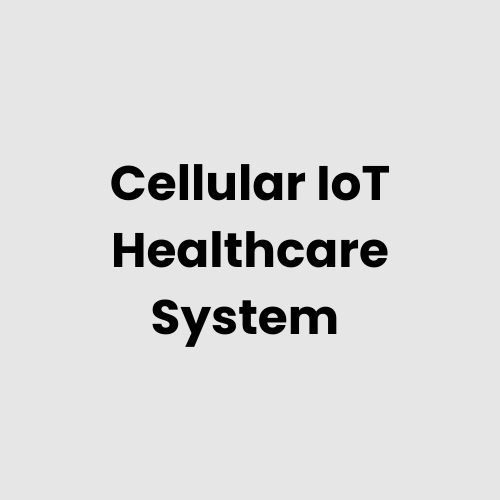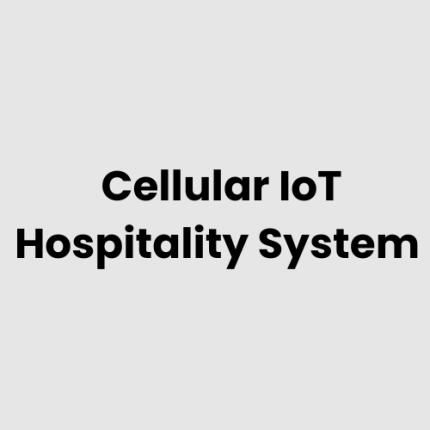Description
Technical Architecture of Cellular IoT Enabled Healthcare IoT (Remote Patient Monitoring) System
GAO Tek’s Cellular IoT Enabled Healthcare IoT (Remote Patient Monitoring) System integrates IoT technology, cellular networks, and cloud infrastructure to enable real-time patient data acquisition, processing, and monitoring. The system features:
- IoT Sensors: Collect vital patient health metrics such as heart rate, oxygen saturation, blood pressure, and glucose levels. Learn more about healthcare IoT applications.
- Cellular Gateways: Enable secure and continuous transmission of patient data via LTE, 5G, or NB-IoT protocols. See more about cellular IoT devices.
- Edge Computing Devices: Perform on-site data preprocessing to reduce latency and bandwidth usage.
- Cloud Servers: Store and analyze large datasets for actionable insights and predictive analytics.
- User Dashboards: Provide healthcare professionals with easy-to-access, real-time data visualization and patient monitoring tools.
Hardware Components of Cellular IoT Enabled Healthcare IoT (Remote Patient Monitoring) System
GAO Tek provides cutting-edge hardware to power this healthcare IoT solution:
- Wearable IoT Devices: Compact health trackers for continuous patient monitoring.
- Medical IoT Sensors: Specialized sensors for measuring patient vitals.
- Cellular Gateways: Reliable communication hubs supporting LTE/5G.
- Edge Processors: AI-enabled local processing units for real-time analysis.
- Local Servers: Secure on-premises servers for clinics or hospitals requiring localized data storage.
- Power Solutions: Battery backups and solar power options for uninterrupted operation.
- Rugged Enclosures: Weatherproof housing for sensors and gateways in outdoor deployments.
Physical Placement Considerations for the Hardware
Proper placement is critical for the system’s efficiency. GAO Tek advises:
- Wearable Devices: Ensure patient comfort and continuous connectivity to gateways.
- IoT Sensors: Install in patient rooms, operating rooms, or ICUs as needed.
- Gateways: Position in central locations with robust cellular network coverage to minimize signal disruptions.
- Edge Devices and Local Servers: Deploy in secure, temperature-controlled environments to ensure reliability.
- Power Solutions: Place near primary hardware with redundancy to maintain continuous operation.
Hardware Architecture of Cellular IoT Enabled Healthcare IoT (Remote Patient Monitoring) System
GAO Tek’s system employs a modular and scalable architecture to support diverse healthcare settings. Features include:
- Decentralized Sensor Networks: Seamlessly integrate sensors across multiple locations, providing granular monitoring.
- Data Redundancy: Includes both local and cloud storage for fail-safe operations.
- Interoperable Gateways: Support multiple IoT standards, including Zigbee, BLE, and LoRaWAN.
- Layered Security: Implements encryption at every stage to ensure data privacy and compliance.
Deployment Considerations of Cellular IoT Enabled Healthcare IoT (Remote Patient Monitoring) System
GAO Tek ensures streamlined deployment with the following recommendations:
- Compliance: Adhere to industry standards and regulations to ensure patient safety.
- Interoperability: Integrate with existing healthcare systems, including EHRs.
- Scalability: Design to accommodate additional sensors or locations as needed.
- Resilience: Use redundant gateways and power solutions to mitigate system downtime.
- Training: Provide comprehensive training for healthcare professionals using the system.
List of Relevant Industry Standards and Regulations
- HIPAA
- ISO/IEC 27001
- ISO 13485
- FDA 21 CFR Part 11
- HL7 FHIR
- IEEE 11073
- GDPR
Local Server Version
GAO Tek offers a localized version of the system that operates independently of the cloud, ensuring greater control over patient data. Features include:
- Data Privacy: Ideal for clinics or hospitals requiring on-premises storage.
- Real-Time Processing: Ensures uninterrupted patient monitoring even in areas with limited internet access.
- Customizable Configuration: Tailor to specific healthcare needs and policies.
Cloud Integration and Data Management
GAO Tek’s system seamlessly integrates with leading cloud platforms, offering:
- Scalable Storage: Efficiently manage data from multiple patients and healthcare facilities.
- Advanced Analytics: Utilize AI-powered predictive models to identify health risks early.
- Remote Accessibility: Empower healthcare professionals to monitor patients from anywhere.
- Data Security: Ensure end-to-end encryption and compliance with stringent data privacy laws.
For more details on our solutions, visit GAO Tek. Additional resources for RFID solutions can be found on GAO RFID.
GAO Case Studies of Cellular IoT Enabled Healthcare IoT (Remote Patient Monitoring) System
- New York City, New York
In New York City, a healthcare provider integrated cellular IoT technology into their remote patient monitoring system. The solution enabled continuous tracking of vital health parameters such as heart rate, blood pressure, and oxygen levels for patients with chronic conditions. This system allowed healthcare providers to receive real-time updates, improving patient care and reducing hospital readmissions. - Los Angeles, California
Los Angeles healthcare facilities deployed a cellular IoT solution to monitor elderly patients with chronic diseases at home. The system tracked patient data such as glucose levels and ECG, automatically sending updates to healthcare professionals. This remote monitoring improved proactive care and allowed immediate intervention, reducing emergency visits and hospital admissions for vulnerable patients. - Chicago, Illinois
In Chicago, a hospital network implemented a cellular IoT system to monitor post-surgical patients. Wearable devices tracked patient recovery data, such as heart rate and temperature, while alerts were sent to caregivers when any abnormalities were detected. This system ensured early detection of potential complications, enhancing patient recovery rates and reducing the need for readmissions. - Houston, Texas
Houston-based healthcare providers utilized cellular IoT to enable remote monitoring of patients with respiratory diseases. Patients wore IoT-enabled devices that tracked their breathing patterns and oxygen levels, with data sent directly to physicians for analysis. This solution allowed for better management of respiratory conditions, improving patient outcomes and reducing emergency room visits. - Miami, Florida
In Miami, healthcare institutions adopted cellular IoT solutions to remotely monitor patients with cardiovascular diseases. Using connected devices, healthcare providers received continuous data on heart rate and blood pressure, enabling early detection of potential issues. The technology ensured timely interventions, improving patient management and reducing hospital visits and healthcare costs. - Phoenix, Arizona
Phoenix healthcare providers integrated a cellular IoT system for monitoring patients with diabetes. The solution used continuous glucose monitors and cellular IoT connectivity to send real-time updates to healthcare professionals. This proactive approach allowed for better diabetes management, reducing the risk of complications and improving the quality of life for patients. - Dallas, Texas
In Dallas, a leading medical center introduced a cellular IoT-based remote monitoring system for patients with chronic obstructive pulmonary disease (COPD). The system tracked key indicators like lung capacity and oxygen saturation levels, alerting healthcare teams to any changes in the patient’s condition. This system helped reduce the frequency of acute episodes and hospitalizations. - San Francisco, California
A healthcare facility in San Francisco integrated cellular IoT technology to monitor high-risk pregnant women. Wearable devices collected vital signs such as heart rate, blood pressure, and fetal heart rate, with data sent to the healthcare provider’s system for analysis. This approach allowed for timely intervention in case of complications, ensuring better maternal and fetal outcomes. - Seattle, Washington
Seattle’s hospitals deployed cellular IoT devices to monitor patients undergoing rehabilitation. The wearable devices tracked physical activity, movement patterns, and physiological data, ensuring that patients were progressing with their treatment plans. Healthcare professionals received real-time feedback, enabling them to adjust treatment as needed and improve patient rehabilitation outcomes. - Washington, D.C.
In Washington, D.C., a healthcare organization used cellular IoT technology to remotely monitor heart failure patients. The system tracked key health indicators such as fluid retention and blood pressure, alerting medical staff to potential problems. By monitoring these patients at home, the system helped reduce emergency visits and hospital admissions while improving long-term care management. - Boston, Massachusetts
Boston-based healthcare providers leveraged cellular IoT technology to monitor high-risk patients in the post-discharge phase. Patients with complex health conditions, such as organ transplants, were equipped with wearable devices that transmitted health data to clinicians in real-time. This system improved early detection of complications and allowed for more personalized care, reducing readmission rates. - Denver, Colorado
In Denver, a local health provider implemented a cellular IoT system to track patients with sleep apnea. The system used connected devices to monitor sleep patterns and breathing irregularities, sending real-time data to healthcare professionals. This allowed for more accurate diagnoses and timely adjustments to treatment plans, reducing the need for in-person follow-ups. - Las Vegas, Nevada
Las Vegas healthcare facilities adopted cellular IoT technology to remotely monitor elderly patients with mobility issues. Wearable sensors tracked vital statistics such as heart rate, blood oxygen levels, and body temperature. This system allowed caregivers to stay informed about patients’ health conditions, facilitating early intervention and reducing the need for hospital visits. - Atlanta, Georgia
Healthcare providers in Atlanta implemented a cellular IoT-based remote monitoring system for patients with mental health disorders. Wearable devices tracked patient stress levels and sleep patterns, while providing real-time data to clinicians. This system helped provide better mental health care by allowing practitioners to respond promptly to changes in a patient’s condition. - Orlando, Florida
In Orlando, Florida, a health system introduced IoT-enabled devices for remote monitoring of patients with chronic pain. These devices tracked physiological signals such as muscle activity and body temperature, with the data sent to healthcare providers. The system helped adjust pain management strategies more effectively, improving patient comfort and reducing emergency visits. - Toronto, Ontario
In Toronto, Canada, a healthcare organization utilized cellular IoT technology to monitor patients with chronic kidney disease. The system collected data on vital signs like blood pressure and renal function, which were transmitted to medical professionals. This enabled early detection of complications and improved patient management, reducing hospital admissions for kidney disease patients. - Vancouver, British Columbia
Vancouver’s medical community embraced cellular IoT technology for monitoring patients with Parkinson’s disease. Wearable devices provided continuous data on movement patterns and tremors, enabling clinicians to adjust treatments based on real-time information. This system allowed for better management of the disease, improving patient mobility and reducing hospital visits.
At GAO Tek Inc., headquartered in New York City and Toronto, Canada, we specialize in advanced solutions for remote patient monitoring. For over four decades, our R&D-driven innovations have helped healthcare professionals leverage cellular IoT technology to improve patient care, reduce hospital admissions, and enable proactive health management. Let GAO Tek help you deploy state-of-the-art remote monitoring systems to meet your healthcare needs. Visit us at GAO Tek Inc.
Navigation Menu for Cellular IoT
- Cellular IoT Accessories
- Cellular IoT Devices
- Cellular IoT – Cloud, Server, PC & Mobile Systems
- Cellular IoT Resources
Navigation Menu for IoT
- LORAWAN
- Wi-Fi HaLow
- Z-WAVE
- BLE & RFID
- NB-IOT
- CELLULAR IOT
- GPS IOT
- IOT SENSORS
- EDGE COMPUTING
- IOT SYSTEMS
Our products are in stock and can be shipped anywhere in the continental U.S. or Canada from our local warehouse. For any further information, please fill out this form or email us.
We are looking for partners. For more information on partnering with GAO, please visit Partner with GAO Tek Inc. It lists various ways to partner with GAO, such as OEM Partnerships, Technology Integration, Distribution and Reselling Opportunities, Presenting at the Leading Event Tek Summit, Joint R&D Projects, Training and Consulting Services, Industry-Specific Collaborations, Research and Academic Partnerships.



